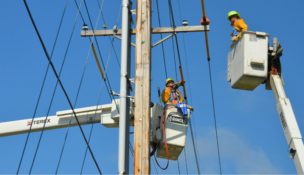Rep. Tom to introduce ‘Megan Evans’ Law’
Arizona Capitol Reports Staff//January 11, 2008//[read_meter]
Rep. Tom to introduce ‘Megan Evans’ Law’
Arizona Capitol Reports Staff//January 11, 2008//[read_meter]
The tragic death of a Flagstaff girl from carbon-monoxide poisoning last summer at Lake Powell has prompted a push from lawmakers and the girl’s family to criminalize dangerous boating behavior.
Megan Evans was swimming with Kayleen Tubbs, her best friend, near a group of houseboats beached in Padre Bay at Lake Powell on a sunny Saturday in July.
Before the day was over, Megan was dead and Kayleen was suffering from a near-fatal dose of carbon monoxide.
The bill, H2024, would require all motorized watercraft to bear a carbon monoxide-warning sticker. The Arizona Game and Fish Department also would design a brochure about carbon monoxide dangers and warning stickers that would be issued to boat owners when a watercraft is sold or registered.
Those who engage in “teak surfing” — the practice of holding onto the teak swim platform at the back of the boat while it is moving — or sit on the swim platform or swim near the boat’s exhaust ports while the engine is running would be charged with a class 2 misdemeanor and could face up to four months in jail and fines of up to $750.
Megan’s story
The dozen or so boats were at Lake Powell that July morning as part of an annual gathering of friends, and the two seven-year-olds were alternating between playing on the beach and swimming in the water.
As the girls played, their fathers each started the motors on their 30-foot cabin cruiser boats to recharge the batteries that had provided electricity the night before. Suddenly, Kayleen’s mother screamed. She had been taking a shower when she noticed her daughter unconscious in the water.
As the girl’s father reached into the water to pull out her limp body, which for some reason was tinged pink from the water, Megan’s father rushed over to his friends to see what was wrong. The girl was not breathing, so the two men began CPR and were able to stabilize the child.
Matt Evans began looking for his own daughter after Kayleen had begun breathing on her own. Someone on a nearby boat said the girl was heading toward the shore when all the commotion began, and Matt Evans figured his daughter must have become scared by what had happened to her friend.
But there were no signs of the girl on the beach. Nor was she still in the water, or on any of the nearby boats.
The adults began looking high and low for her, but it would be 30 more minutes before Megan’s lifeless body would be found, submerged in about six feet water. A medical helicopter arrived and ferried the girls to Page Hospital. While Kayleen was administered oxygen and her condition improved, doctors pronounced Megan dead.
Megan Evans’ Law
A post-mortem exam revealed Megan Evans had a carbon monoxide saturation of 65 percent. The girl had been inhaling the colorless, odorless and tasteless gas as she swam and had passed out, slipping below the water’s surface.
Doctors also determined carbon monoxide had caused Kayleen Tubbs to lose consciousness. Her saturation, though, was only 26 percent, a dangerous but not fatal level.
Matt Evans and his wife Jennifer have asked Arizona lawmakers to pass a law that would inform boat owners about the dangers of carbon monoxide, as well as criminalize some behaviors that could put boaters and their passengers at risk. Though avid boaters, the Evanses say they weren’t aware of the danger posed by carbon-monoxide exposure.
“These are things we’d done hundreds of times before, thinking it was OK to do,” Matt Evans said at a Jan. 8 press conference. “It wasn’t, and we paid the ultimate price.”
Marine engines are not subject to the same emission controls as cars and can produce upwards of 180 times the carbon monoxide as automobiles. They produce so much of the gas that on calm days, invisible clouds of the odorless gas can form in the open air.
Swimmers, boat passengers — possibly dockworkers and passers-by — can be exposed to doses that cause dizziness, unconsciousness, even death.
There have been 141 deaths recorded nationwide and an additional 600 non-lethal poisonings caused by carbon monoxide produced by boat engines since 1995, said Rep. Albert Tom, D-2, the sponsor of the legislation, which he calls “Megan Evans’ Law.”
“This is why Megan’s bill is so critical. It will save lives,” he said. “This bill will educate every boat owner in Arizona that when their boat engine is running, it is a potential killer.”
But Sen. Ron Gould, R-7, whose district includes most of the Colorado River, as well as popular boating destinations at Lake Havasu and Lake Mead, said the bill’s provisions are too extreme.
“Making it a criminal offense is kind of ridiculous,” Gould said, noting the penalties for automobile violations are civil offenses, not criminal.
Gould, who lives in Lake Havasu City and is an avid boater, said he also didn’t think there was a need to require the state Game and Fish Department to distribute warning stickers or brochures. Instead, the department could design an educational program and use some of the money it already collects for boat registrations to distribute warnings to boaters.
“This stuff is a lot better handled through education, not legislation,” he said.
California passed a similar law in 2004. Washington and Utah are considering similar measures this year.
















